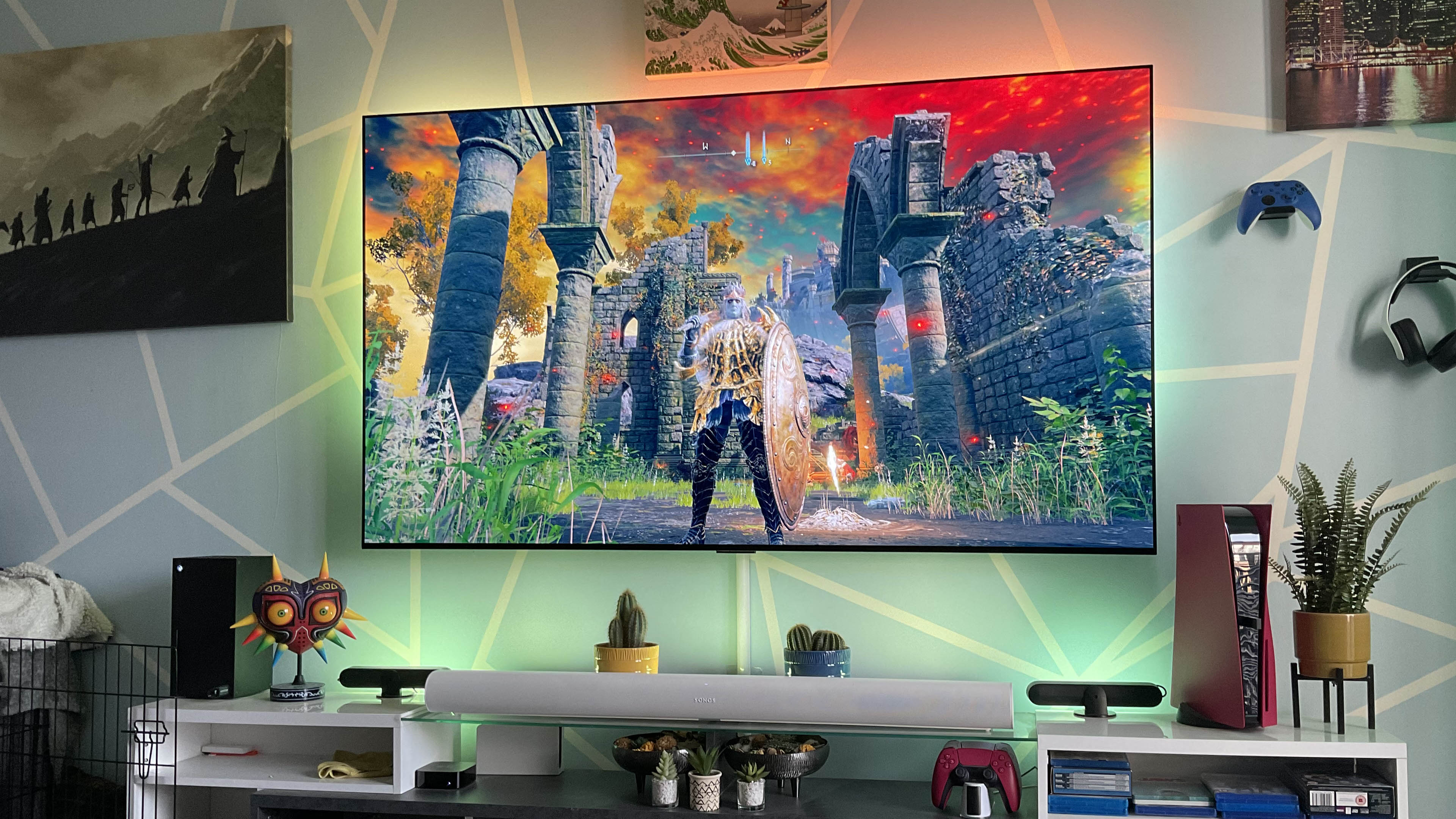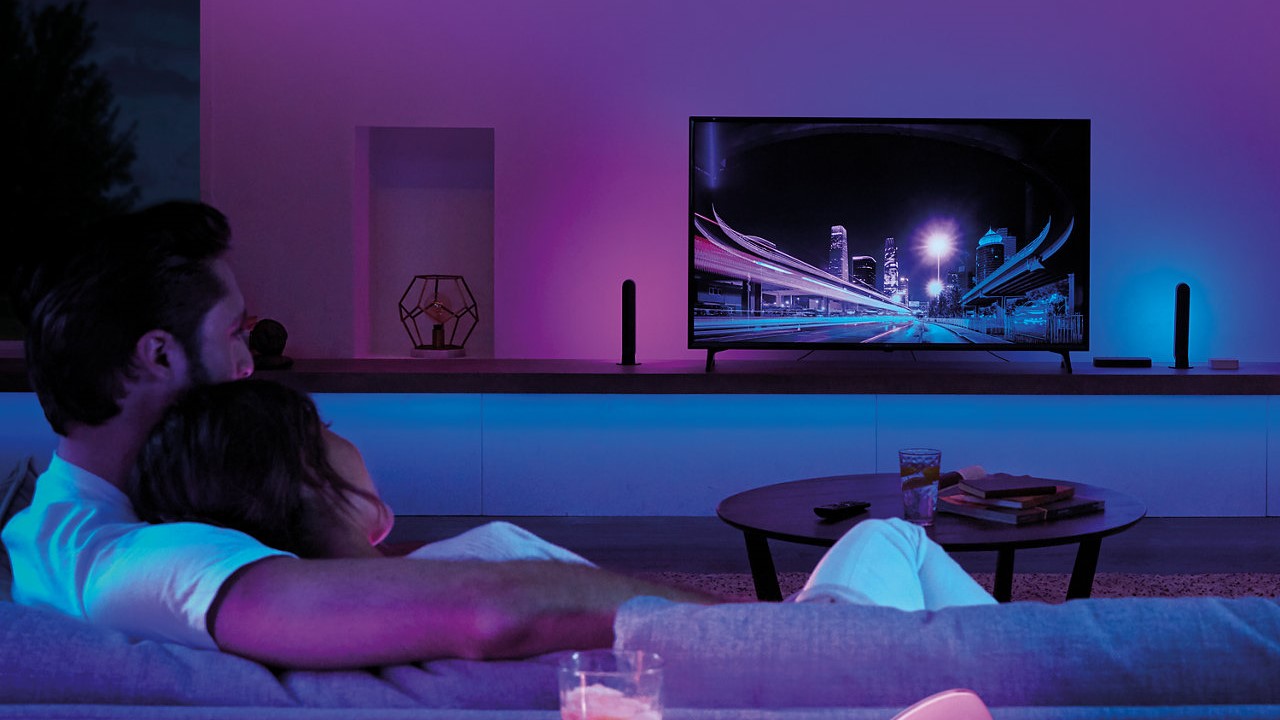I love using the Philips Hue Sync Box with my TV, but it needs an HDMI 2.1 upgrade for PS5
The color-changing tech is amazing for a home theater, yet it’s HDMI 2.0 limitations are being felt more and more

I’ve been both a Philips Ambilight addict and a fan of Hue Play equipment for years. It’s a love affair that started when I bought 2019’s Philips OLED 984 – both a kickass TV and the first set to introduce me to this color-casting tech. Four years on, Ive changed TV, but I can't go without the lighting. I’m now using a Philips Hue Gradient Lightstrip paired with the Philips Hue Play Sync Box with my LG C2. It’s a dream lighting setup, but one that’s missing a key feature when it comes to gaming.
Before I gently grumble about the Hue Play Sync Box’s only real failing, let me get into why I love these forms of lighting tech so much. With the news that Samsung TVs will soon support Ambilight light-syncing (albeit through an expensive app), I’ve been thinking about these technologies a lot.
If you’re not familiar with Ambilight TVs or Hue Play hardware, here’s a quick explainer of the smart lighting technologies. Both project colors onto the wall behind a TV that matches what's on-screen, giving you the feeling of an even bigger screen, but they’re separate forms of tech. The main distinction between these two pieces of color-projecting gear? Philips-exclusive Ambilight TVs come with built-in LEDs and can match any image that's going through the TV; a Hue Play system requires lights such as the Hue Play Gradient Strip to be connected to the Hue Play Sync Box, and the Sync Box acts as an HDMI hub – the lights can match any image from sources that go through the box.
In a further (slightly confusing) wrinkle, neither LED tech is actually manufactured by Philips. Hue Play equipment is made by Signify, while Ambilight TVs are produced by TP Vision. Caught up? Lovely.
Follow the Ambilight
After I sold my Philips OLED 984 and switched to the LG OLED C2 – hands-down the best TV I’ve ever owned, and top of our guide to the best OLED TVs – I bought the Hue Play Sync Box. It’s a nifty little HDMI hub; one that lets you connect four different devices, then syncs the colors of a paired Hue Play lightstrip to match your on-screen content.
After a quick setup through the slightly fiddly Hue Sync app via smartphone or tablet, the Sync Box and Hue Gradient Lightstrip instantly match whatever array of colors are being displayed on the TV. I’ve currently got my PS5, Xbox Series X, Apple TV, and Nintendo Switch hooked up to the Sync Box, and switching between sources is mostly a pain-free process.

Whether you’re playing the best PS5 games or watching one of the best Netflix movies, the Hue Play Sync Box and Hue Gradient Lightstrip heighten immersion at every turn. A good example of the effect in action? Watch The Matrix, and a constant array of glassy greens will illuminate the wall behind your TV to match the Wachowski’s masterful, bullet-dodging color palette.
Sign up for breaking news, reviews, opinion, top tech deals, and more.
Thanks to the Hue Sync app, you can tweak the intensity of the color-syncing tech. I tend to go for the lowest ‘Subtle’ preset when watching movies, then ramp it up to High when playing games. And it’s with games that you really see the best of the Sync Box and lightstrip.
Whether having my corneas singed by searing reds in frantic games of Rollerdrome or feeling the warmth of The Witcher 3’s perpetual autumnal tones expanded beyond the dimensions of my LG C2, it’s a terrific effect that makes both games and movies feel more three-dimensional.
There’s a catch when it comes to next-gen consoles, though. With more and more PS5 and Xbox Series X games supporting frame rates of 120 at 4K, the slightly ageing Sync Box’s flaw is revealed: it doesn’t support HDMI 2.1. This means it’s restricted to 4K/60Hz signals, or 120Hz at 1440p.
Out of sync
While the lack of 120Hz passthrough at 4K isn’t a game-breaker for the Hue Play Sync Box, it does lead to compromises. I recently completed last year’s excellent God of War: Ragnarok on PS5, and because I chose to plump for the High Frame Rate mode, I was forced into an annoyingly fiddly cycle of regularly switching out HDMI cables.
With High Frame Rate enabled, Ragnarok regularly runs between 90-120fps. To hit this buttery performance, though, I had to bypass the HDMI 2.0 limitations of the Sync Box, instead using a different, hideously long HDMI 2.1 cable that I plugged into a different output on the back of my LG C2 OLED. Sure, all those extra frames makes garotting an ogre smoother than ever, but it also meant I could no longer mimic the icy blues of Kratos’ frigid Midgard via my Sync Box and lightstrip.

Is this a First World Sophie’s Choice moment deserving of the tiniest violin yet conceived by theoretical physics? Of course. Still, having to regularly switch HDMI cables when choosing between games that support 4K 120Hz and those that are limited to 60Hz (that I want to sync the colors of) is annoying.
If Philips Hue was to release an HDMI 2.1 version of the Sync Box that supported 4K 120Hz passthrough with Variable Refresh Rate, all my future-proofed gaming prayers would be answered. Not that this is likely to be a cheap solution – the HDMI 2.0 Sync Box already costs $250/£230. Throw in an extra $299/£185 for the 75-inch Hue Play Gradient Lightstrip I pair with my 77-inch C2 OLED, and all this creative color has hit my tattered bank balance hard.
But for this ambient light-loving addict, the prospect of playing games at 4K 120fps while simultaneously syncing the colors of glorious virtual worlds through Hue Play gear would be worth the assault to my wallet. C’mon Hue; make that HDMI 2.1 Sync Box happen to pair with the best gaming TVs.
Dave is a freelancer who's been writing about tech and video games since 2006, with bylines across GamesRadar+, Total Film, PC Gamer, and Edge. He's been obsessed with all manner of AV equipment ever since his parents first bought him a hideously garish 13-inch CRT TV (complete with built-in VCR, no less) back in 1998. Over the years he’s owned more plasma and OLED TVs than he can count. On an average day, he spends 30% of his waking existence having mild panic attacks about vertical banding and dead pixels.
